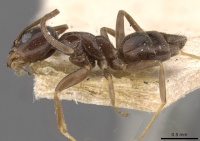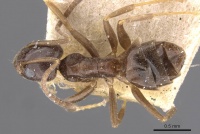Tapinoma israele
| Tapinoma israele | |
|---|---|

| |
| Scientific classification | |
| Kingdom: | Animalia |
| Phylum: | Arthropoda |
| Class: | Insecta |
| Order: | Hymenoptera |
| Family: | Formicidae |
| Subfamily: | Dolichoderinae |
| Genus: | Tapinoma |
| Species: | T. israele |
| Binomial name | |
| Tapinoma israele Forel, 1904 | |
Identification
Keys including this Species
Distribution
Latitudinal Distribution Pattern
Latitudinal Range: 34.87875° to 32.72973333°.
| North Temperate |
North Subtropical |
Tropical | South Subtropical |
South Temperate |
- Source: AntMaps
Distribution based on Regional Taxon Lists
Palaearctic Region: Algeria, Israel (type locality).
Distribution based on AntMaps
Distribution based on AntWeb specimens
Check data from AntWeb
Countries Occupied
| Number of countries occupied by this species based on AntWiki Regional Taxon Lists. In general, fewer countries occupied indicates a narrower range, while more countries indicates a more widespread species. |

|
Estimated Abundance
| Relative abundance based on number of AntMaps records per species (this species within the purple bar). Fewer records (to the left) indicates a less abundant/encountered species while more records (to the right) indicates more abundant/encountered species. |

|
Biology
Castes
Nomenclature
The following information is derived from Barry Bolton's Online Catalogue of the Ants of the World.
- israele. Tapinoma erraticum r. israelis Forel, 1904c: 16 (w.) ISRAEL. Emery, 1925d: 58 (q.). Raised to species: Emery, 1925d: 58.
Description
References
- Berville, L., Hefetz, A., Espadaler, X., Lenior, A., Renuuci, M., Blight, O., Provost, E. 2013. Differentiation of the ant genus Tapinoma (Hymenoptera: Formicidae) from the Mediterranean Basin by species-specific cuticular hydrocarbon profiles. Myrmecological News 18: 77-92.
- Berville, L., Hefetz, A., Espadaler, X., Lenoir, A., Renucci, M., Blight, O. & Provot, E. 2013. Differentiation of the ant genus Tapinoma (Hymenoptera: Formicidae) from the Mediterranean Basin by species-specific hydrocarbon profiles. Myrmecological News 18, 77-92.
- Borowiec, L. & Salata, S. 2013. Ants of Greece – additions and corrections (Hymenoptera Formicidae). Genus (Wroclaw) 24, 335-401.
- Borowiec, L. 2014. Catalogue of ants of Europe, the Mediterranean Basin and adjacent regions (Hymenoptera: Formicidae). Genus (Wroclaw) 25(1-2): 1-340.
- Demetriou, J., Georgiadis, C., Ralli, V., Salata, S., Borowiec, L. 2024. Setting the record straight: a re-examination of ants (Hymenoptera: Formicidae) from Cyprus deposited at the Museum of Zoology of Athens. Zootaxa 55231, 49–69 (doi:10.11646/zootaxa.5523.1.3).
- Emery, C. 1925d. Hymenoptera. Fam. Formicidae. Subfam. Formicinae. Genera Insectorum 183: 1-302 (page 58, queen described)
- Emery, C. 1925d. Hymenoptera. Fam. Formicidae. Subfam. Formicinae. Genera Insectorum 183: 1-302 (page 58, Raised to species)
- Forel, A. 1904d. Miscellanea myrmécologiques. Rev. Suisse Zool. 12: 1-52 (page 16, worker described)
- Salata, S., Borowiec, L., Trichas, A. 2020. Review of ants (Hymenoptera: Formicidae) of Crete, with keys to species determination and zoogeographical remarks. Monographs of the Upper Silesian Museum No 12: 5–296 (doi:10.5281/ZENODO.3738001).
References based on Global Ant Biodiversity Informatics
- Baroni Urbani C. 1977. Katalog der Typen von Formicidae (Hymenoptera) der Sammlung des Naturhistorischen Museums Basel (2. Teil). Mitt. Entomol. Ges. Basel (n.s.) 27: 61-102.
- Berville L., A. Hefetz, X. Espadaler, A. Lenoir, M. Renucci, O. Blight, and E. Provost. 2013. Differentiation of the ant genus Tapinoma (Hymenoptera: Formicidae) from the Mediterranean Basin by specis-specific cuticular hydrocarbons profiles. Myrmecological News 18: 77-92.
- Borowiec L. 2014. Catalogue of ants of Europe, the Mediterranean Basin and adjacent regions (Hymenoptera: Formicidae). Genus (Wroclaw) 25(1-2): 1-340.
- Borowiec L., and S. Salata. 2012. Ants of Greece - Checklist, comments and new faunistic data (Hymenoptera: Formicidae). Genus 23(4): 461-563.
- Emery C. 1913. Hymenoptera. Fam. Formicidae. Subfam. Dolichoderinae. Genera Insectorum 137: 1-50.
- Emery C. 1925. Revision des espèces paléarctiques du genre Tapinoma. Revue Suisse de Zoologie 32: 45-64.
- Finzi B. 1930. Hymenopteren aus Palästina und Syrien. (Zoologische Studienreise von R. Ebner 1928 mit Unterstützung der Akademie der Wissenschaften in Wien.) Formicidae. Sitzungsberichte der Akademie der Wissenschaften in Wien. Mathematisch-Naturwissenschaftliche Klasse. Abteilung I 139:22-24.
- Forel A. 1904. Miscellanea myrmécologiques. Rev. Suisse Zool. 12: 1-52.
- Forel, A. "Miscellanea myrmécologiques." Revue Suisse de Zoologie 12 (1904): 1-52.
- Martinez J. J. 2008. Firebreaks in planted pine forests in Israel: patches for Mediterranean Bata ants. Vie et Milieu 58(3/4): 233-236.
- Santschi F. 1930. Trois notes myrmécologiques. Bulletin et Annales de la Société Entomologique de Belgique. 70: 263-270.
- Santschi, F. "Fourmis d'une croisière." Bulletin et Annales de la Société Entomologique de Belgique (Bruxelles) 74 (1934): 273-282.
- Shattuck S. O. 1994. Taxonomic catalog of the ant subfamilies Aneuretinae and Dolichoderinae (Hymenoptera: Formicidae). University of California Publications in Entomology 112: i-xix, 1-241.
- Tohme G. 1996. Formicidae. Etude de la diversité biologique n° 4 . Ministère de lAgriculture à Beyrouth (Eds.). P85-87.
- Tohme G., and H. Tohme. 2014. Nouvelles liste des especes de fourmis du Liban (Hymenoptera, Formicoidea). Lebanese Science Journal 15(1): 133-141.
- Vonshak M., and A. Ionescu-Hirsch. 2009. A checklist of the ants of Israel (Hymenoptera: Formicidae). Israel Journal of Entomology 39: 33-55.

